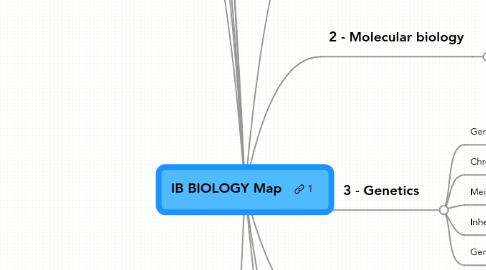
1. 7 - Nucleic acids
1.1. DNA structure and replication
1.1.1. DNA polymerase I
1.1.2. DNA polymerase III
1.1.3. base sequencing
1.1.4. DNA gyrase
1.1.5. DNA primase
1.1.6. DNA profiling
1.1.7. DNA replication
1.1.8. helicase
1.1.9. histone
1.1.10. intron
1.1.11. lagging strand
1.1.12. leading strand
1.1.13. nucleosome
1.1.14. nucleotide
1.1.15. replication fork
1.1.16. tandem repeats
1.1.17. telomere
1.1.18. X-ray diffraction
1.2. Transcription and gene expression
1.2.1. 5' to 3' direction
1.2.2. DNA methylation
1.2.3. exon
1.2.4. gene expression
1.2.5. genome
1.2.6. intron
1.2.7. non-coding DNA
1.2.8. nucleosome
1.2.9. promoter
1.2.10. repressor
1.2.11. splicing of mRNA
1.2.12. terminator
1.2.13. transcription
1.3. Translation
1.3.1. alpha helix
1.3.2. beta pleated sheet
1.3.3. bound ribosome
1.3.4. conjugated protein
1.3.5. conformations
1.3.6. electron micrograph
1.3.7. free ribosomes
1.3.8. non-polar amino acid
1.3.9. polar amino acid
1.3.10. polypeptide
1.3.11. polysome
1.3.12. primary structure
1.3.13. prosthetic group
1.3.14. quaternary structure
1.3.15. R group
1.3.16. secondary structure
1.3.17. tertiary structure
1.3.18. translation
1.3.19. tRNA
1.3.20. tRNA-activating enzyme
2. 8 - Metabolism, cell respiration and photosynthesis
2.1. Metabolism
2.2. Cell respiration
2.3. Photosynthesis
3. 9 - Plant biology
3.1. Transport in the xylem of plants
3.2. Transport in the phloem of plants
3.3. Growth in plants
3.4. Reproduction in plants
4. 10 - Genetics and evolution
4.1. Meiosis
4.2. Inheritance
4.3. Gene pools and speciation
5. 11 - Animal physiology
5.1. Antibody production and vaccination
5.2. Movement
5.3. The kidney and osmoregulation
5.4. Sexual reproduction
6. A - Neurobiology and behavior
6.1. Neural development
6.1.1. axon
6.1.2. chordate
6.1.3. dorsal fin
6.1.4. ectoderm
6.1.5. endoderm
6.1.6. mesoderm
6.1.7. neural development
6.1.8. neural pruning
6.1.9. neural tube
6.1.10. neuron
6.1.11. neuroscience
6.1.12. neurulation
6.1.13. notochord
6.1.14. plasticity of the nervous system
6.1.15. spina bifida
6.1.16. synapses
6.2. The human brain
6.2.1. autonomic nervous system
6.2.2. Broca's area
6.2.3. Cerebral cortex
6.2.4. Cerebral hemispheres
6.2.5. Electroencephalogram
6.2.6. fMRI (functional magnetic resonance imaging)
6.2.7. Homunculus
6.2.8. Medulla oblongata
6.2.9. motor cortex
6.2.10. pituitary gland
6.2.11. pupil reflex
6.2.12. Somatosensory cortex
6.2.13. visual cortex
6.3. Perception of stimuli
6.3.1. aqueous humor
6.3.2. auditory nerve
6.3.3. bipolar cells
6.3.4. blind spot
6.3.5. chemoreceptors
6.3.6. choroid
6.3.7. cochlea
6.3.8. color blindness
6.3.9. cones
6.3.10. conjunctiva
6.3.11. cornea
6.3.12. eardrum
6.3.13. fovea
6.3.14. ganglion cell
6.3.15. iris
6.3.16. lens
6.3.17. mechanoreceptors
6.3.18. olfactory receptors
6.3.19. optic nerve
6.3.20. oval window
6.3.21. photoreceptors
6.3.22. pinna
6.3.23. pupil
6.3.24. round window
6.3.25. sclera
6.3.26. semicircular canals
6.3.27. stimulu
6.3.28. thermoreceptor
6.3.29. trichromatic vision
6.3.30. visual cortex
6.3.31. vitreous humor
6.4. Innate and learned behavior
6.4.1. autonomic responses
6.4.2. effector
6.4.3. imprinting
6.4.4. innate behavior
6.4.5. involuntary responses
6.4.6. learned behavior
6.4.7. motor neuron
6.4.8. operant conditioning
6.4.9. receptor cell
6.4.10. reflex arcs
6.4.11. reflex conditioning
6.4.12. reflex
6.4.13. relay neuron
6.4.14. sensory neuron
6.4.15. withdrawal reflex
6.5. Neuropharmacology
6.5.1. addiction
6.5.2. amphetamine
6.5.3. anaesthetic
6.5.4. benzodiazepines
6.5.5. cocaine
6.5.6. dopamine
6.5.7. ecstasy
6.5.8. endorphins
6.5.9. neuropharmacology
6.5.10. neurotransmitter
6.5.11. nicotine
6.5.12. post-synaptic neuron
6.5.13. pre-synaptic neuron
6.5.14. serotonin
6.5.15. summation
6.5.16. sympathetic nervous system
6.5.17. Tetrahydrocannabinol (THC)
6.6. Ethology
6.6.1. altruistic behavior
6.6.2. courtship
6.6.3. ethology
6.6.4. foraging behavior
6.6.5. innate behavior
6.6.6. learned behavior
6.6.7. natural selection
6.6.8. synchronized oestrus
